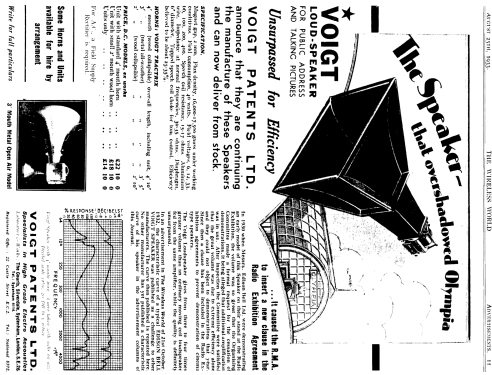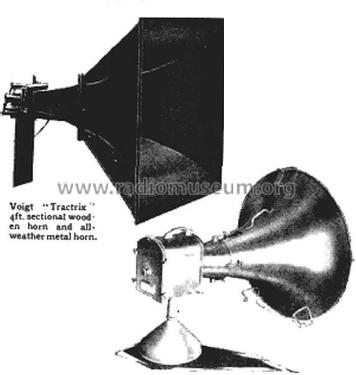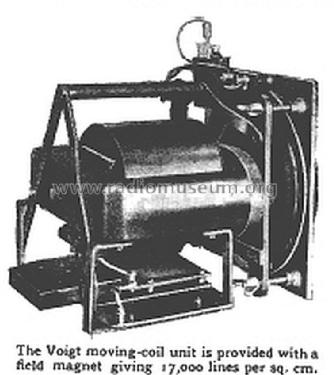Tractrix Horn with Moving Coil Loudspeaker
Voigt Patents Ltd.; Sydenham
- Produttore / Marca
- Voigt Patents Ltd.; Sydenham
- Anno
- 1933
- Categoria
- Altoparlante, cuffia o auricolare
- Radiomuseum.org ID
- 340306
Clicca sulla miniatura dello schema per richiederlo come documento gratuito.
- Principio generale
- Amplificatore audio
- Gamme d'onda
- - senza
- Tensioni di funzionamento
- Alimentazione a corrente continua (CC) / See below Volt
- Altoparlante
- AP elettrodinamico (bobina mobile e bobina di eccitazione/di campo) / Ø 6 inch = 15.2 cm
- Materiali
- Speciale materiale, descritti nelle note.
- Radiomuseum.org
- Modello: Tractrix Horn with Moving Coil Loudspeaker - Voigt Patents Ltd.; Sydenham
- Forma
- Diverse forme (descritte nelle note).
- Annotazioni
-
Tractrix Horn with Moving Coil Loudspeaker.
Specification
- Magnet gap: 2 mm,
- Flux density: 16,000-17,500 gauss under working conditions.
- Field consumption: 40 watts.
- Field voltages: 6, 12, 33, 66, 100, 200 & 400 V.
- Speech coil resistance: 15-17 Ω.
- Aluminum wire.
- Impedance at normal frequencies: 30-35 Ω.
- Diaphragm: 6” diameter
- Tapped speech coil choke for tone control.
- Efficiency believed to be 25-35%
- For AC field supply a rectifier is required.
Horns: Voight Tractrix
4 ft mouth (wood collapsible), overall length, including unit 4’ 10”.
4 ft mouth (metal all-weather), overall length, including unit 3’ 5”
2ft. mouth (wood collapsible), overall length, including unit 2’ 10”.Price DC models. ex-works
Unit with standard 4’ mouth horn £22-10-0
Unit with small 2’ mouth wood horn £18-10-0
Units only £14-10-0
- Prezzo nel primo anno
- 22.50 GB £
- Bibliografia
- Wireless World (The), London (WW, 79) (Sep 29, 1933, Page 274.)
- Letteratura / Schemi (1)
- Wireless World (The), London (WW, 79) (Aug 25, 1933, Page Advert 11.)
- Autore
- Modello inviato da Gary Cowans. Utilizzare "Proponi modifica" per inviare ulteriori dati.
- Altri modelli
-
In questo link sono elencati 6 modelli, di cui 6 con immagini e 1 con schemi.
Elenco delle radio e altri apparecchi della Voigt Patents Ltd.; Sydenham
Discussioni nel forum su questo modello: Voigt Patents Ltd.;: Tractrix Horn with Moving Coil Loudspeaker
Argomenti: 1 | Articoli: 1
Extracted from the Lowther Voigt Radio, Season 1936-37, Page 23.
THE VOIGT " TRACTRIX " LOUDSPEAKER HORN.
The Voigt "Tractrix" Loudspeaker Horn will increase the volume and improve the tone of any ordinary loudspeaker unit.
The "Tractrix" is the only curve for a horn that really takes into account the fact that sound (particularly at low frequencies) spreads spherically and not with a plane wavefront.
An air column bounded by this curve loads the diaphragm at its small end and radiates sound energy at its mouth more uniformly and efficiently than the well-known exponential or logarithmic horn.
Radiation resistance at the mouth of the "Tractrix" Horn is such that the sound is immediately transmitted to the surrounding air, and air-column refraction does not occur.
The Standard horn (shown in fig.) is straight, with a mouth 4 feet square and a throat (small end) 4 inches square. The overall length is only 4 feet 10 inches including the unit.
The standard 4-foot horn loads the diaphragm from the 128 cycles upwards.
At frequencies below the horn "cut-off", the use of a wide-throat horn with a large diaphragm has a big advantage over the older style of small-throat horn fed from a small diaphragm because the actual volume of air displaced is much greater with the larger diaphragm. "Horn action" is,
therefore, not nearly so necessary for the production of sounds of low frequencies.
Consequently. the response does not cut off abruptly as with small-diaphragm units on long horns but holds for a little on account of the air column, and then falls away gradually until it reaches the volume level obtained with a baffle.
The response is still considerable, as much as an octave below the "cut-off" frequency.
The fact that the horn loads the diaphragm well at all frequencies not only maintains the response down to and below the horn "cut-off" but helps greatly to preserve the natural tone of transients.
The horn carries any sound energy to be transmitted immediately from the diaphragm surface to the surrounding air.
The delay common to ordinary baffle speakers, which is so detrimental to "attack", while the diaphragm works itself up to full amplitude is thus avoided.
When the loudspeaker is intended for any purpose for which reproduction at full strength of the fundamentals of the lowest musical frequencies is unimportant or when a different speaker is used for the bass the 2-foot mouth horn is very suitable.
This horn has the advantage of taking up little space. the overall length inclusive of the unit is 2 feet, 10 inches. It loads the diaphragm from 250 cycles upwards.
Gary Cowans, 03.Oct.22


